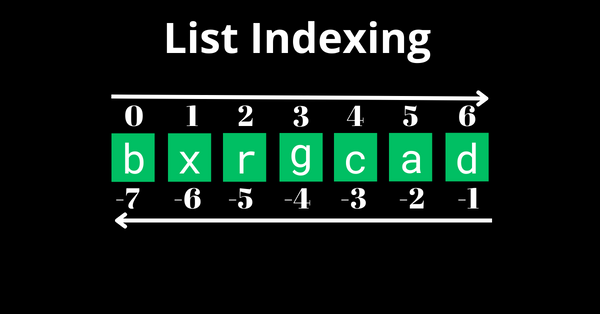Python has several methods and hacks for getting the index of an item in iterable data like a list, tuple, and dictionary.
In this article, we are looking at how you can get the index of a list item with the index() method. I’ll also show you a function that is equivalent to the index() method.
What We'll Cover
- What is the
index()Method of a List? - How to Get the Index of a List item with the
index()Method - How to Use the
startandstopParameters of theindex()Method - How to Get the Index of a List Item with the
enumerate()Function - Conclusion
What is the index() Method of a List?
The index() method does what the name implies – it lets you get the index of an item in a list. It takes the item you want to search for its index in the list and returns its position in that list.
Apart from the item you want to search for, the index() method also takes the optional parameters start and stop. start is the position you want the index() method to start looking for the item, and stop is the position you want it to stop searching for the item.
Here’s what the syntax of index() looks like:
list.index(item_to_search_for, start_position, stop_position)
Be aware that the items in a list are zero-indexed. So, the first item takes the index 0, the second item takes 1, the third takes 2, and so on.
That doesn’t mean if 6 is the last index in a list, the length is 6. In this case, the length is 7. If you want to start referencing a list of 7 items from the last item, the last item will be -1, and the first item will be -7.

How to Get the Index of a List item with the index() Method
To get the index of an item in a list, attach the index() method to the list and pass in the item to the index() method:
herbivores = ["Giraffe", "Goat", "Sheep", "Cattle", "Antelope", "Rabbit"]
print(herbivores.index("Goat")) # Output: 1
You can also extract the index to a separate variable this way:
herbivores = ["Giraffe", "Goat", "Sheep", "Cattle", "Antelope", "Rabbit"]
index_of_goat = herbivores.index("Goat") # Output: 1
print(index_of_goat)
If the item is a duplicate, the index() method would only take the first occurrence into account and ignore the others:
herbivores = ["Goat", "Giraffe", "Sheep", "Cattle", "Antelope", "Giraffe" "Rabbit"]
index_of_giraffe = herbivores.index("Giraffe")
print(index_of_giraffe) # Output: 1
omnivores = ["Pig", "Dogs", "Duck" "Bears" "Ostrich", "Hen", "Warthog", "Bears", "Dogs"]
index_of_dogs = omnivores.index("Dogs")
print(index_of_dogs) # Output: 1
How to Use the start and stop Parameters of the index() Method
As already pointed out, you can use the start and stop parameters to specify where the index() method should start searching for the item and stop searching for it.
Let's see how the start parameter works first. In the omnivores list below, let’s search for the position of the second occurrence of Dogs:
omnivores = ["Pig", "Dogs", "Duck", "Ostrich", "Warthog", "Dogs", "Bears"]
# Since we know the first occurrence is at index `1`, we can start the searching from `index 2`
index_of_dogs = omnivores.index("Dogs", 2 )
print(index_of_dogs) # Output: 5
You can get the position of the first occurrence of Dogs by specifying 0 as the start and anything between 2 and 4 as the stop:
omnivores = ["Pig", "Dogs", "Duck", "Ostrich", "Warthog", "Dogs", "Bears"]
index_of_dogs = omnivores.index("Dogs", 0, 4 )
print(index_of_dogs) # Output: 1
If the item is not within the range you specify, you get an valueError exception:
omnivores = ["Pig", "Dogs", "Duck", "Ostrich", "Warthog", "Dogs", "Bears"]
index_of_dogs = omnivores.index("Dogs", 2, 4 )
print(index_of_dogs) # Output: ValueError: 'Dogs' is not in list
How to Get the Index of a List Item with the enumerate() Function
The enumerate() function can keep track of the positions of items in a list, tuple, or other iterable sequences of data. So, we can also use it to get the index of an item in a list.
This makes enumerate() an equivalent of the index() method. The difference is that enumerate() returns the position(s) as a list and it can return the indices of multiple occurrences of the same item.
Here’s an example:
herbivores = ["Goat", "Ram", "Sheep", "Cattle", "Antelope", "Giraffe", "Rabbit"]
index_of_ram = [i for i, j in enumerate(herbivores) if j == 'Ram']
print(index_of_ram) # [1]
In the code above:
- I used a list comprehension to find the index of the element in the list that contains the string
Ram - The enumerate() function iterated over the
herbivoreslist and keep track of the position of each element in the list - The
enumerate()function takes an iterable object (in this case, herbivores) as its argument and returns an iterator that generates pairs of the form (index, element) for each element in the iterable irepresents the index of the element in theherbivoreslist andjrepresents the element itself- The
ifstatement checks if the element is equal to the stringRam. If it is, then the index of the element (i) is added to the resulting list
The enumerate() function would also return the indices of duplicate items:
omnivores = ["Pig", "Dogs", "Duck", "Ostrich", "Warthog", "Dogs", "Bears"]
indices_of_dogs = [i for i, e in enumerate(omnivores) if e == 'Dogs']
print(indices_of_dogs) # [1, 5]
Conclusion
The index() method of list is a straightforward way to get the position [or index] of an item in a list.
But unfortunately, index() would take care of the first item and ignore the rest if it’s a duplicate. That’s why we also looked at how to get the indices of duplicate items in a list.
So, if what you want to do is to get the positions of multiple items in a list, then enumerate() is the right option for you.
Happy coding!

